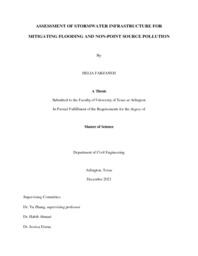
ATTENTION: The works hosted here are being migrated to a new repository that will consolidate resources, improve discoverability, and better show UTA's research impact on the global community. We will update authors as the migration progresses. Please see MavMatrix for more information.
Show simple item record
| dc.contributor.advisor | Zhang, Yu | |
| dc.creator | Farzaneh, Helia | |
| dc.date.accessioned | 2023-06-28T14:50:47Z | |
| dc.date.available | 2023-06-28T14:50:47Z | |
| dc.date.created | 2021-12 | |
| dc.date.issued | 2021-12-14 | |
| dc.date.submitted | December 2021 | |
| dc.identifier.uri | http://hdl.handle.net/10106/31366 | |
| dc.description.abstract | Flooding is the top natural hazard impacting coastal and inland communities in Texas. Beyond its destructive impact on rising waters in communities, flooding-induced stormwater negatively affects the quality of large bodies of water. Stormwater runs over land, washes off pollutants, and deposits them into rivers which causes water quality issues in bays and estuaries. In addition, the stormwater increases nutrients, sediments, oxygen-demanding substances, pathogens, and toxins which results in hypoxia in the aquatic system. During the last 5-6 years, severe storm events such as Tropical Storm Beta (September 2020), Tropical Storm Imelda (September 2019), Hurricane Harvey (August 2017) have caused a fatality and billions in damages along the Gulf Coast region. These events have shown that stormwater and wastewater infrastructures for many coastal and near-coastal communities are inadequately prepared for the frequency and magnitude of these storms. Infrastructure upgrades are costly to implement and maintain. Many smaller urban and rural coastal communities are unlikely to have the resources to complete infrastructure upgrades that will enhance their resiliency during flooding events.
Texas has been working to implement the Coastal Nonpoint Source (CNPS) Program, which includes promoting and facilitating the implementation of stormwater best management practices (known as BMPs) in small urban and urbanizing coastal areas. These practices are distinguished by whether engineering (structural) or administrative (nonstructural) procedures are taken. In this study, BMPs as techniques, practices, or structural controls are used to manage and mitigate the quantity and quality of stormwater runoff to the greatest extent possible. To do this, between different types of BMPs such as wet detention ponds, dry detention pond, swales, constructed wetlands, and levees, the most effective BMPs have been selected. For application of these BMPs, three scenarios are defined. This work develops a decision framework to provide opportunities for coastal communities to assess the performance of stormwater infrastructures vulnerable to flooding risk using up-to-date precipitation frequency estimates and determine the most cost-effective scenario to alleviate stormwater runoff and downstream water quality issues arising from flood events. The resultant scenario is used to appraise the cost-effectiveness of stormwater BMPs in mitigating the impacts of flooding on water quality in the flood-prone lower Neches River region. The analysis yields a table of the cost of BMP implementation, estimate flood risk reductions in terms of stormwater peak flow reduction, and potential improvements to water quality measures. | |
| dc.format.mimetype | application/pdf | |
| dc.language.iso | en_US | |
| dc.subject | Flood risk management | |
| dc.subject | Best management practices | |
| dc.subject | Flood mitigation | |
| dc.subject | SWMM | |
| dc.subject | MOPUS | |
| dc.subject | Nonpoint source pollution | |
| dc.title | ASSESSMENT OF STORMWATER INFRASTRUCTURE FOR MITIGATING FLOODING AND NON-POINT SOURCE POLLUTION | |
| dc.type | Thesis | |
| dc.date.updated | 2023-06-28T14:50:47Z | |
| thesis.degree.department | Civil Engineering | |
| thesis.degree.grantor | The University of Texas at Arlington | |
| thesis.degree.level | Masters | |
| thesis.degree.name | Master of Science in Civil Engineering | |
| dc.type.material | text | |
| dc.creator.orcid | 0000-0003-3489-7314 | |
Files in this item
- Name:
- FARZANEH-THESIS-2021.pdf
- Size:
- 1.856Mb
- Format:
- PDF
This item appears in the following Collection(s)
Show simple item record


